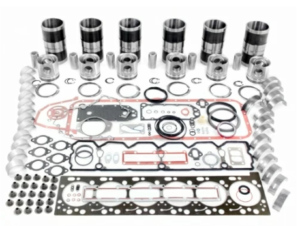February 27, 2025
Introduction
1. Preparation for Engine Disassembly and Assembly
1.1 Understanding the Engine Layout
1.2 Tools Required for Disassembly and Assembly
2. Step-by-Step Breakdown of Engine Disassembly
2.1 Pre-Disassembly Preparation
2.2 Cylinder Head and Valve Train Disassembly
2.3 Turbocharger, Air Intake, and Exhaust System Removal
2.4 Fuel System Removal
2.5 Crankshaft, Pistons, and Internal Components Disassembly
3. Best Practices to Avoid Damage During Disassembly
4. Step-by-Step Breakdown of Engine Assembly
4.1 Preparing for Assembly
4.2 Crankshaft and Piston Installation
4.3 Reinstalling Fuel System Components
4.4 Cylinder Head and Valve Train Assembly
4.5 Turbocharger, Air Intake, and Exhaust Installation
5. Best Practices to Avoid Damage During Assembly
Conclusion
Read More
February 27, 2025
Introduction
1. Recommended Service Schedule for Optimal Engine Performance
1.1 Daily Maintenance Checklist
1.2 Service Intervals: 250 Hours or Monthly Maintenance
1.3 Service Intervals: 500 Hours or Quarterly Maintenance
1.4 Service Intervals: 1,000 Hours or Annual Maintenance
1.5 Service Intervals: 2,000 Hours or Bi-Annual Maintenance
2.1 Valve Lash Inspection and Adjustment
2.2 Turbocharger Inspection
2.3 Cooling System Inspection
2.4 Fuel System Inspection
3. Fluids, Filters, and Lubrication Requirements
3.1 Engine Oil Requirements
3.2 Fuel System Maintenance
3.3 Coolant Requirements
Conclusion
Read More
February 27, 2025
Introduction: The Importance of Safety When Servicing Diesel Engines
1. Essential Safety Guidelines Before Servicing
1.1 General Safety Precautions
2. Handling Hazardous Materials: Fuel, Coolant, and Lubricants
2.1 Diesel Fuel Safety Precautions
2.2 Engine Coolant (Antifreeze) Safety Precautions
2.3 Engine Oil and Lubricant Safety
3. Proper Ventilation and Protective Gear Requirements
3.1 Importance of Ventilation in Diesel Engine Workspaces
3.2 Protective Gear Requirements for Diesel Engine Servicing
4. Emergency Procedures for Diesel Engine Servicing
4.1 Fire Safety Procedures
4.2 First Aid for Fuel, Oil, or Coolant Exposure
5. Hazardous Energy and Lockout/Tagout (LOTO) Procedures
5.1 Understanding Hazardous Energy Sources
5.2 Steps for Lockout/Tagout (LOTO) Procedures
6. Fire Prevention and Emergency Preparedness
6.1 Common Fire Hazards in Diesel Engine Servicing
6.2 Fire Prevention Measures
6.3 What to Do in Case of Fire
7. Safe Handling of High-Pressure Fuel Injection Systems
7.1 Risks of High-Pressure Fuel Systems
7.2 Safety Guidelines for Fuel System Work
8. Safe Lifting and Handling of Heavy Engine Components
8.1 Heavy Component Weight Considerations
8.2 Safe Lifting Techniques
9. Conclusion: Prioritizing Safety for Efficient Engine Maintenance
 Key Takeaways:
Key Takeaways:
Read More
February 27, 2025
Introduction
General Engine Information
Cummins QSC 8.3 Overview
Cummins QSL 9 Overview
Engine Specifications
Cummins QSC 8.3 Engine Specifications
Cummins QSL 9 Engine Specifications
Key Features and Advantages of Cummins QSC 8.3 & QSL 9
1. High-Pressure Common Rail (HPCR) Fuel Injection System
2. Advanced Electronic Control System
3. Turbocharged and Aftercooled Design
4. Heavy-Duty Engine Block and Internal Components
5. High-Efficiency Cooling System
6. Environmentally Friendly and Emissions-Compliant
Identification and Serial Number Location
Where to Find the Serial Number on a Cummins QSC 8.3 and QSL 9
Decoding Cummins Engine Serial Numbers
What is a CPL Number?
Conclusion
Read More
February 27, 2025
Introduction
Understanding the Cummins QSC 8.3 and QSL 9 Engines
Cummins QSC 8.3 Overview
Key Features of the QSC 8.3
Applications of the QSC 8.3
Cummins QSL 9 Overview
Applications of the QSL 9
Importance of Regular Maintenance and Repairs
Benefits of Proper Maintenance
Recommended Maintenance Schedule for Cummins QSC 8.3 and QSL 9
Daily Maintenance Checks
Every 250 Hours (or Monthly)
Every 500 Hours (or Quarterly)
Every 1,000 Hours (or Annually)
Every 2,000 Hours (or Bi-Annually)
Common Issues and Troubleshooting for QSC 8.3 & QSL 9 Engines
1. Fuel System Problems
2. Overheating Issues
3. Oil Leaks
Performance Optimization Tips
Conclusion
Read More
Page 3 of 14«12345...10...»Last »




 Free US Calls: 1-888-433-4735
Free US Calls: 1-888-433-4735 International: 305-545-5588
International: 305-545-5588

